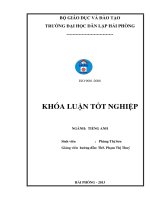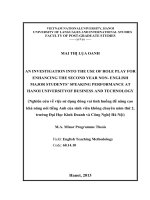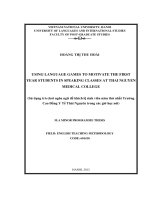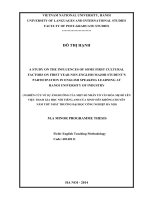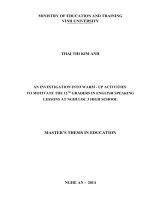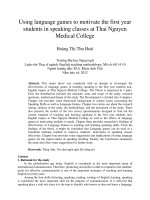Using role play to improve the 1st year students english speaking skill at vietnamese university of traditional medicine
Bạn đang xem bản rút gọn của tài liệu. Xem và tải ngay bản đầy đủ của tài liệu tại đây (1.32 MB, 82 trang )
LÊ THỊ TUYẾT MAI
VIETNAM ACADEMY OF SOCIAL SCIENCES
GRADUATE ACADEMY OF SOCIAL SCIENCES
Lê Thị Tuyết Mai
ENGLISH LANGUAGE
USING ROLE - PLAY TO IMPROVE THE
FIRST - YEAR STUDENTS’ ENGLISH
SPEAKING SKILL AT VIETNAMESE
UNIVERSITY OF TRADITIONAL MEDICINE
MA THESIS IN ENGLISH LANGUAGE
COURSE: 2016 – 2018
HANOI, 2018
1
VIETNAM ACADEMY OF SOCIAL SCIENCES
GRADUATE ACADEMY OF SOCIAL SCIENCES
Lê Thị Tuyết Mai
USING ROLE-PLAY TO IMPROVE THE
FIRST-YEAR STUDENTS’ ENGLISHSPEAKING SKILL AT VIETNAMESE
UNIVERSITY OF TRADITIONAL MEDICINE
Field: English Language
Code: 8220201
Supervisor: Phạm Hiển, Ph.D.
HANOI, 2018
DECLARATION BY AUTHOR
I declare that this “Using role play to improve the 1st year students'
English-speaking skill at Vietnamese University of Traditional Medicine” is
created by my own findings and I am the sole author of this thesis. To the best
of my knowledge, with the exception of the indication of reference, this is
carried out without using any other author’s work and is submitted after a
carefully checking progress in order to fulfill the requirements of the M.A
degree.
Author’s signature
Lê Thị Tuyết Mai
Approved by
SUPERVISOR
Phạm Hiển, Ph.D.
Date: ………………………………
i
ACKNOWLEDGEMENTS
This thesis is completed with lots of working hours and is contributed
by a large amount of enthusiasm, effort and assistance from many people.
First and the foremost, I would like to express my gratitude to my
supervisor, Phạm Hiển,Ph.D. for all of his support. If it had not been for his
guidance, as long as the advice and comments from him, I would not complete
this research paper.
Moreover, I would like to send my special thanks to all of teachers at
Vietnamese University of Traditional Medicine for all their help and
suggestion which are very necessary and useful to me during the progress of
completing this .
Additionally, I am so grateful for all of the assistance from the students
at Vietnamese University of Traditional Medicine with their answers for all of
the interview, I would not have completed this research paper otherwise.
Last but not least, I would like to send my special thanks to my beloved
family, who are always supportive and enthusiastic to me during the progress
of making this .
ii
ABSTRACT
This is created and completed on the purpose of researching the way of
using Role-Play as an effective teaching method, especially in the scope of
teaching English at universities. According to the theoretical foundation about
Role-Play implementation, the aim of this is to enhance the English-speaking
competence of students in the first year of the university. Furthermore,
applying Role-Play method is becoming more and more popular in teaching
and guiding English speaking skill to the students, therefore, this focuses on
analyzing the necessity as well as the way of using this helpful method in
universities, particularly the Vietnamese University of Traditional Medicine.
Figures, data and information was collected and analyzed mainly through
surveys, questionnaires and interview which was conducted by 100 first-year
students at Vietnamese University of Traditional Medicine. The benefits,
positive effects, as well as challenges of applying this teaching method are
analyzed in this . Furthermore, some suggestions for overcoming these
difficulties are also mentioned.
iii
TABLE OF CONTENTS
DECLARATION BY AUTHOR ....................................................................... i
ACKNOWLEDGEMENTS .............................................................................. ii
ABSTRACT ..................................................................................................... iii
LIST OF TABLES AND FIGURES ............................................................... vii
CHAPTER 1: INTRODUCTION .................................................................. 1
1.1. Rationale ................................................................................................ 1
1.2. Aims of the Study................................................................................... 2
1.3. Research Questions ................................................................................ 2
1.4. Scope of the Study ................................................................................. 2
1.5. Significance of the Study ....................................................................... 3
1.6. Research Methods .................................................................................. 3
1.7. Organization of the Study ...................................................................... 3
CHAPTER 2: LITERATURE REVIEW...................................................... 5
2.1. An Overview of a Method of Teaching and Learning the Skill of
English-Speaking .......................................................................................... 5
2.1.1 A Language Teaching Method with Surprising Effectiveness:
Communicative Language Teaching Approach (CLT) ................................. 5
2.1.1.1. Communicative Language Teaching Approach: Definition .......... 5
2.1.1.2. An Overview of CLT Approach’s Aims .......................................... 6
2.1.2. A Description of an Effective Way of Learning English-Speaking
Skill ................................................................................................................ 7
2.2. An Introduction of Role-Play in Teaching the Skill of Speaking .......... 8
2.2.1. Definition of Role-Play ....................................................................... 8
2.2.2. Forms of Role-Play ............................................................................. 9
2.2.3. The Steps for Role-Play Activity ....................................................... 10
iv
2.2.4. The Necessity of Role-Play Method in Teaching the Skill of Speaking
..................................................................................................................... 13
2.2.5. The Teachers’ Role in this Activity ................................................... 13
2.3. Chapter Summary................................................................................. 14
CHAPTER 3: METHODOLOGY............................................................... 15
3.1. Research Questions .............................................................................. 15
3.2. Research Participants: The Researcher and The Subjects ................... 15
3.3. Research Procedure .............................................................................. 15
3.4. Instruments of Collecting Data. ........................................................... 15
3.4.1. Survey Questionnaires ...................................................................... 15
3.4.2. Observations ..................................................................................... 17
3.4.3. Interview ............................................................................................ 18
3.5. Assessment ........................................................................................... 18
3.6. Chapter Summary................................................................................. 18
CHAPTER 4: FINDINGS AND DISCUSSIONS ....................................... 19
4.1. A Brief Analysis of the Survey’s Results ............................................ 19
4.1.1. Questionnaires .................................................................................. 19
4.1.1.1. Questionnaire for Students. ......................................................... 19
4.1.1.2. Questionnaire for Teaches ........................................................... 38
4.1.2. Interviewing....................................................................................... 46
4.1.2.1. Teachers’ Interviewing ................................................................ 46
4.1.2.2. Student’s Interviewing ................................................................. 48
4.1.3. Observations ..................................................................................... 49
4.1.3.1. The first Observation ................................................................... 49
4.1.3.2.The second Observation ................................................................ 51
4.2. Discussions........................................................................................... 52
4.2.1. Research Question 1: ........................................................................ 52
v
4.2.2. Research Question 2: ........................................................................ 52
4.3.Assessment: ........................................................................................... 53
4.3.1.Class’s Situation before Applying Method. ....................................... 53
4.3.2.Application Progress.......................................................................... 55
4.3.3.Class’s Situation after Applying Method. .......................................... 55
4.4.Chapter Summary.................................................................................. 57
CHAPTER 5: CONCLUSION ..................................................................... 59
5.1. Recapitulation ...................................................................................... 59
5.2.Concluding Remarks ............................................................................. 59
5.3.Implications ........................................................................................... 60
5.4. Limitations and Suggestions for Further Studies ................................. 60
REFERENCES ................................................................................................. I
APPENDIX: QUESTIONNAIRES ............................................................. III
vi
LISTS OF TABLES
Tables of Students’ Survey Questionnaire Analysis
Table 1: Students’ Level of Involvement in a Particular Lesson ................ 20
Table 2: Students’ Opinion about Role-Play Activities done in Class ....... 21
Table 3: Students’ Level of Impression on the Activities .......................... 21
Table 4: Was Students’ Confidence improved after Exercises................... 22
Table 5.1: Students’ Opinion about Today’s Lesson: LEVEL OF
HELPFULNESS ......................................................................................... 23
Table 5.2: Students’ Opinion about Today’s Lesson: LEVEL OF
DIFFICULTY ............................................................................................. 24
Table 6: The Skill Needs Improving ........................................................... 25
Table 7: Self-evaluation of Students about their Communicative Skill in
English......................................................................................................... 26
Table 8: Whether Developing Speaking Skills during Classes is Essential ...
................................................................................................................. 27
Table 9: Do you find it difficult to communicate in English? .................... 29
Table 10: Factors Prevent Students from talking English fluently ............. 30
Table 11: Have you ever played a role during a language lesson? ............. 31
Table 12: Preference for Playing Roles than other Activities in Class....... 32
Table 13: Frequency of using Role-Play in English Speaking Classes of
Students. ...................................................................................................... 33
Table 14: Feelings when Participating in Role-Play Activities .................. 34
Table 15: Difficulties in Applying Role-Play in Speaking Classes ............ 35
Table 16: Factors Influencing Role-Play Classes ....................................... 36
Table 17: Reasons for the Excitement of Role-Play Classes ...................... 37
Tables of students’ survey questionnaire analysis
Table 1: Viewpoint of Teachers on Student’s Speaking Competence ....... 38
Table 2: Viewpoint of Teachers about Students’ Attitude to Learning
Speaking ...................................................................................................... 39
Table 3: Teachers’ Application of Role-Play Method in Class .................. 40
vii
Table 4: Benefits of Applying Role-Play.................................................... 41
Table 5: Level of Difficulties in Applying Role-Play ................................ 42
Table 6: Difficulties when Applying Role-Play: Reasons .......................... 43
Table 7: Frequency of Using Role-Play in Class ........................................ 44
Table 8: Viewpoint about Students’ Enhancement ..................................... 44
viii
LIST OF FIGURES
Figures of students’ survey questionnaire analysis
Figure 1: Students’ Level of Involvement in a Particular Lesson .............. 20
Figure 2: Students’ Opinion about Role-Play Activities done in Class...... 21
Figure 3: Students’ Level of Impression on the Activities ......................... 22
Figure 4: Was Students’ Confidence improved after Exercises ................. 23
Figure 5.1: Students’ Opinion about Today’s Lesson: Level of Helpfulness24
Figure 5.2: Students’ Opinion about Today’s Lesson: Level of Difficulty 25
Figure 6: The Skill Needs Improving ........................................................ 26
Figure 7: Self-evaluation of Students about their Communicative Skill in
English......................................................................................................... 27
Figure 8: Whether Developing Speaking Skills during Classes is Essential28
Figure 9: Do you find it difficult to communicate in English? ................... 29
Figure 10: Factor Prevents Students from talking English fluently ........... 30
Figure 11: Have you ever played a role during a language lesson? ........... 31
Figure 12: Preference for Playing Roles than other Activities in Class ..... 32
Figure 13: Frequency of using Role-Play in English Speaking Classes of
Students. ...................................................................................................... 33
Figure 14: Feelings when Participating in Role-Play Activities ................ 34
Figure 15: Difficulties in Applying Role-Play in Speaking Classes .......... 35
Figure 16 Factors Influencing a Role-Play Classes .................................... 36
Figure 17: Reasons for the Excitement of Role-Play Classes .................... 37
ix
Figures of students’ survey questionnaire analysis
Figure 1: Viewpoint of Teachers on Student’s Speaking Competence ...... 38
Figure 2: Viewpoint of Teachers about Students’ Attitude to Learning
Speaking ...................................................................................................... 39
Figure 3: Teachers’ Application of Role-Play Method in Class................. 40
Figure 4: Benefits of Applying Role-Play .................................................. 41
Figure 5: Level of Difficulties in Applying Role-Play ............................... 42
Figure 6: Difficulties when Applying Role-Play: Reasons ........................ 43
Figure 7: Frequency of Using Role-Play in Class ...................................... 44
Figure 8: Viewpoint about Students’ Enhancement ................................... 45
x
CHAPTER 1: INTRODUCTION
This chapter introduces some very first parts of the ; there are seven
parts in this chapter: (1) Rationale; (2) Aims of the study; (3) Research
Methods; (4) Scope of the Study; (5) Significance of the Study; (6) Research
Methods and (7) Organization of the Study.
1.1. Rationale
It is undeniable that improving the ability of using English of students,
especially the speaking skills, is the key and responsibility of teaching
English in our contemporary society. Due to the fact that speaking is one of
the most popular and most-used skills when a student access to the program
of learning English, many teachers are finding their own ways, methods and
steps with a view to helping their students to enhance their English
competence. Obviously, when a student can communicate with others by
using English fluently and correctly, they can find it easier to use and speak
English with their foreign friends, partners or colleagues without any
difficulties.
However, apparently, the method of conveying knowledge of English
in our country nowadays is still simple. Students are approached the content
of the lesson just by the things that their teacher says. Additionally, in many
high schools in Vietnam, speaking is the skill which is often neglected, since
teachers spend almost all time for teaching grammar; therefore, students lack
the chances to practice speaking. As a result, when they enter a higher
education system, such as university, they do not know how to speak English
properly and may lose their interest in speaking English.
In order to improve this issue, renew the teaching method is of great
importance. Once students’ confidence on their speaking ability is increased,
their communicative skills will be enhanced; they can use and speak English
1
comfortably and fluently. On the purpose of fulfilling this aim, changing the
atmosphere of each speaking lesson is necessary. There are a wide range of
methods on which English teachers can base in order to carry out the new
teaching style, and Role-Play allows access to both teachers and students to
this.
Base on the analysis and reasons mentioned above, a conclusion could
be reached is that we pursue to a conclusion to carry out the thesis “Using role
play to improve the 1st year students' English-speaking skill at Vietnamese
University of Traditional Medicine”. By doing this , we believe that it can
help teachers, especially teachers working with students in the first year of
universities a method of enhancing their English-speaking competence.
1.2. Aims of the Study
The goal of this thesis is to elevate the speaking skills of first year
students at a university. Moreover, this
can help teachers recognize the
benefits of this method in order to apply it in their classes.
1.3. Research Questions
The is conducted in order to support the answers of these following
questions:
Question 1: What are the 1st year students' attitude toward using role play
activity?
Question 2: In what way does role play improve 1st year students' speaking
skill?
1.4. Scope of the Study
The scope of the study is about approaching and using Role-Play as a
new method of teaching and improving the skill of Speaking on first-year
students at Vietnamese University of Traditional Medicine.
2
1.5. Significance of the Study
It is hoped from the that it can raise the awareness of teachers and
students of the importance of Role-Play in English speaking skill so that
learners can speak English more appropriately and spontaneously. Moreover,
the advantages, difficulties, as well as some useful recommendation and
solutions of this method mentioned and analyzed in this thesis could help
teachers to find out the most suitable way to apply this method to their
students.
1.6. Research Method
In order to complete this , we have to study some theoretical
methodologies; and outstandingly, there are three research methods on which
data, figures and information are based and collected: questionnaires,
interview and observation.
The first step which is used to collect the data is questionnaires. There
were 100 first-year students at Vietnamese University of Traditional Medicine
participated in the questionnaire. Besides, there are ten teachers at Vietnamese
University of Traditional Medicine took part in an interview also on the
purpose of collecting some necessary information which can help we carry
out the more effectively by analyzing their valuable opinion and viewpoints.
After that, with a view to recognizing the way of applying and the effect, as
well as difficulties of this method in classes, the author of observed a certain
amount of lessons in classes.
1.7. Organization of the Study
The thesis consists of five chapters:
Chapter 1: Introduction
This part presents a general view of the thesis. Motivation, aims,
methods scope, significance as well as the structure of the can be found in
3
this chapter.
Chapter 2: Literature review
In this chapter, a basic theoretical background about knowledge and
analytic basis of teaching English-speaking skill and Role-Play method at
schools and universities is provided.
Chapter 3: Methodology
This chapter presents not only a view of questions used in the
questionnaires and the interview but also the research questions, procedure,
participants, the way of collecting figures and data and how them are
analyzed.
Chapter 4: Findings and discussions
As aptly named, this part presents and analyses the results of the
questionnaires carried out in 100 first-year students at the class of Y-A1 at
Vietnamese University of Traditional Medicine. Furthermore, analysis after
observing classes and teachers’ interview are also included in this part.
Chapter 5: Conclusion
This chapter holds responsible for providing an overview of the whole ,
including benefits and limitations of the study as well. By analyzing this
information, some recommendation for further research are also suggested.
4
CHAPTER 2: LITERATURE REVIEW
2.1. An Overview of a Method of Teaching and Learning the Skill of
English-speaking
Due to the fact that learning the skill of speaking is of great importance
to every English learner, numerous of researchers and scholars found some
ways and methods to convey the knowledge of learning speaking effectively
to their students, especially students in the countries where English is
considered the second language. After a long procedure of adaptation and
changes, there are several most popular and effective methods of teaching
speaking, which are still being applied at schools in many nations, including
Communicative Language Teaching approach and Role-Play. In the first part
of this chapter, a general view of these two ways of teaching is provided, go
along with an analysis of the characteristics of each of them; and, obviously,
Role-Play is mainly focused.
2.1.1. A Language Teaching Method with Surprising Effectiveness:
Communicative Language Teaching approach (CLT)
Communicative language teaching approach is considered one of the most
popular methods of teaching and improving student’s English competence.
This part includes some analysis basing on background knowledge from
scholars to find out more about this method.
2.1.1.1.Communicative Language Teaching Approach: Definition
On the purpose of conducting a lesson of English, there are two most
common methods which are being used widely around the world, especially
in Vietnam: Audio-lingual method and Communicative language teaching
approach (CLT).
Regarding to Communicative language teaching approach (CLT), or
the communicative approach, “is an approach to language teaching that
5
emphasizes interaction as both the means and the ultimate goal of study.”
(Nunan, David;1991)
This method of language access bases mainly on real-life situations to
which important communication aspects are related. According to Yule,
George (2006), in a lesson in which CLT method is used, the teacher creates a
situation which is very popular to the students; including daily conversation;
communication manners; etc. and their duty is practice speaking.
Apparently, there is a minor difference between Communicative
Language Teaching approach (CLT) and Audio-lingual method. While
Audio-lingual method of teaching bases mainly on drills and repetition, CLT
requires a creativeness and involvement in activities in class actively due to
the fact that the simulations relied on real-life situation are varied from
lessons to the others. This motivation encourages learners to speak
enthusiastically and meaningfully.
It is written to explain the view of Firth(1957) by an expert in the field
of CLT – Bernsthat "language is interaction; it is interpersonal activity and
has a clear relationship with society.” In this light, language study has to look
at the use (function) of language in context, both its linguistic context (what is
uttered before and after a given piece of discourse) and its social, or
situational, context (who is speaking, what their social roles are, why they
have come together to speak).
2.1.1.2. An Overview of CLT Approach’s Aims
Each way of approaching an effective teaching method has its own
aims and purposes. Regarding to CLT, it is obvious that building and
developing learners’ ability of communicating proficiently inside and outside
the classroom is the mail goal of CLT approach. When teachers and learners
get an achievement in fulfilling this goal, the fear of incorrect speaking or
6
making grammatical mistakes during conversation of students will no longer
exist. That is considered a remarkable improvement of the competence of
communicating of the students, especially first-year students at universities.
2.1.2. A Description of an Effective Way of Learning English-Speaking
Skill
Basing on the analysis and viewpoint of Chaney (1998), that speaking
is “the process of sharing meaning through the use of verbal and non- verbal
symbol, in a variety of context” and the foregoing viewpoint of Berns about
the characteristics of language and its relationship with society; it can be
understood that due to the fact that English; when is spoken in countries
where people don’t use it as their first language, is somehow difficult. This
phenomenon is especially true to the learning situation in Vietnam. As a
result, when they learn English, especially the skill of speaking, they often
practice it by a process of imitation and repetition of drills. However, an
effective speaking lesson is a requirement of great interaction among students.
The more activities in which communicative purpose students can participate,
the more improvable they can get in their speaking skill.
On the purpose of achieving the goal of CLT approach, there are some
possibilities and progress for learners as a reference to follow. The first step is
that there must be a recognition from learners that it shouldn’t be a burden or
pressure when learning English. Instead of feeling uncomfortable, learners
had better consider learning English is a hobby and take it easy. A class with a
learning-friendly environment will, certainly, stimulate the learning interest
from students.
Additionally, it’s widely known that another important complement of
enhancing the skill of speaking English is a range of grammar and
vocabulary. Undoubtedly, a basic knowledge of words and grammatical
7
aspect has a great impact on how a student can produce a proper response will
definitely happen when they have enough word ranges to use and they don’t
have to concern too much on how correctly grammar is used.
Moreover, speaking style is another necessary factor which must be
taken notice of when learning speaking, since there is a substantial difference
between a person who speak timidly with a lot of fluctuation and interruption
and the others with a confident style of speaking. A person can speak and
convey their expression fluently and confidently requires a great deal of
efforts and practice.
2.2. An Introduction of Role-Play in Teaching the Skill of Speaking
This part holds responsible for introducing the main method on which
the focuses – Role-Play.
2.2.1. Definition of Role-Play
“Role-Play” itself is a compound noun which is combined with two
independent words: “role”, which is defined as the person whom an actor
represents in film or play by, and “play”, which means that is taken on in a
safe environment in which students are as an inventive and playful as
possible, which can be found in Role Play: Resources Book for Teacher
Series by Gillian Porter Ladousse. It is also mentioned by Ladousse(1987)
that role play is a method of acting out particular way of behaving or
pretending to be other people who deal with new situations. It is used in
training courses language learning and psychotherapy.
Role-Play is a very common method of teaching speaking, that is the
reason why there are many ways to define it. Particularly, Horner &Mc.Ginley
(1990), described it on her article with the title "Role Play" that Role-Play is
any speaking activity when you either put yourself into somebody else's shoes,
or when you stay in your own shoes but put yourself into imaginary situation.
8
In other words, it can be explained that in a lesson which involve RolePlayactivities, students are not themselves anymore. They can imagine to
become whoever they like, from ordinary people such as a worker, farmer or an
assistant to people with high social status like The President or a celebrity.
Becoming and understanding the character which is played will be a key to
develop the ability of critical thinking, as a result, improve the speaking
competence of student.
It could be summarized from definitions mentioned above that RolePlay is a teaching technique that taking advantages of the benefits of
practicing speaking though counterfeit situation and conversation. Participants
in activities involving Role-Play method imagine themselves to be another
people for a short duration of time or until they finish the conversation. It is
considered an encouragement without which students could never have
achieved the goal of improving speaking skill because Role-Play activities
can help students to think and respond creatively and practice speaking
English in a comfortable atmosphere, and, last but not least, build the
confidence of speaking to the students.
2.2.2. Forms of Role-Play
There are two forms of Role-Play, based on the viewpoint of
Mc.Gill(1995), which will be mentioned below. The first form is Scripted
Role-Play, which have a relation to the involvement of the interpretation in
textbook conversation, or, reading text in the speech form; and the other is
Unscripted Role-Play. Different from the first form, the situation of
Unscripted Role-Play, or known by another name – free Role-Play, is
independent of the contents of the course book. According to Turner (1992),
the feature which make Unscripted Role-Play differ from Scripted Role-Play
is the decision of language used and the development of the dialogue.
9
Because Unscripted Role-Play activities do not use guidance from course
book, it is more creative and comfortable for both students and teachers to
produce a talk; however, go along with this creativeness is the requirement of
a good preparation from teachers and learners.
2.2.3. The Steps for Role-Play Activity
In order to carry out a successful lesson with Role-Play actives, it is
necessary to conduct in steps. It is suggested in the book Role-Play in
Teaching Culture: Six Quick Steps for Classroom Implementation by the
author Kodotchigova that there are six steps which can be used to make an
effective lesson.
o Step 1- Choose an appropriate situation
According to Livingstone (1983), the first step is choosing a situation
for a role play, keeping in mind students' needs and interests. One of the most
popular and suitable way to the teacher is that he or she can choose exactly
what the students have just learned to form a speaking topic, as it will be a
terrific opportunity for them to practice and apply speaking structures and
vocabularies related to the lessons’ contents that they have just been
conveyed. More interestingly, teacher can let students choose the topic and
situation themselves, provided that it fits the cultural features of the country.
o Step 2 - Role Play Design
When the situation of the conversation is formed after discussion and
reaching a consensus on the topic, it is high time to carry out the second step
is to generalize the ideas about the development of the situation. It is also
noted by Livingstone (1983) that: “Students' level of language proficiency
should be taken into consideration carefully when carrying out any activities.”
This opinion is clarified by the viewpoint ofBlake & Mouton (1980) that on
low intermediate and more advanced levels, role play with problems or
10
conflicts in them work very well because they motivate the characters to talk.
o Step 3 - A Preparation in the aspect of Linguistic
It can be explained that the necessary communicative language depends
on the competence level of the students. It is also mentioned by Livingstone
(1983) that at the beginning level, the language needed is almost completely
predictable. The higher the level of students the more difficult it is to
prefigure accurately what language students will need, but some prediction is
possible anyway; and it is an evidence for the fact that teacher, in order to
develop the situation, can help students by guiding some lead-in questions.
Furthermore, according to Byrne (1983), it is recommended to introduce any
new vocabulary, structure or pronunciation before any role play activities can
be begun. Take a situation in a cinema as an example, when a student, now
become a customer, wants to buy a movie ticket. Another student will be a
staff and help him or her to purchase. Teacher can help by asking some
questions like: “What are the customer is going to ask in this situation?” or
“How can he ask the staff to buy a ticket”?
o Step 4 - Factual Preparation
According to Van Ments(1999), the main function of this step is to
provide students with more detailed information and describe the role of each
student clearly. For example, when a situation about the working condition is
formed, the teacher and students should set up and present information about
it as much as possible, including the name, position and the scale of the
company. Moreover, the context “working condition” should also be
described thoroughly by some illustration like the working hours, salary, the
manager’s and colleagues’ behavior, etc. This step will help students imagine
more easily about the job that they are going to becoming, so that they will act
11
more confidently.
In order to collect this kind of detailed information, it is necessary for
teacher to ask student to prepare the contents of the lesson at home in
advance. For example, if the topic for the lesson is “working condition”,
students can search at home about the working condition in a certain
company.
o Step 5- Assigning the Roles
This step is also noted by Harasim&Turoff(1995), that some instructors
ask for volunteers to act out a role play in front of the class because it can be a
model for student to follow. Even if nobody wants to be a volunteer, teacher
can help by acting out for the first time, because when students access to this
method for the first time, they might not have known what to do and need
guidance from teacher. In case there is not much time left, teacher can ask
students to perform their play at home as a preparation and will act in the next
lesson. It is mentioned by many scholars that doing Role-Play activities with
friends could be very effective, such as the opinion of Horner
&Mc.Ginley(1990) that very often, optimum interaction can be reached by
letting the students work in one group with their friends.
o Step 6 - Follow-up
After finishing the activities using Role-Play, teacher should spend time
on debriefing, which not focus mainly on pointing out and correcting mistakes
made by students during the time they take part in activities. According to
Milroy (1982); Horner &Mc.Ginley (1990), debrief, or follow-up, means
asking every students opinion about the role play and welcoming their
comments. This step is necessary and should be happened due to the fact that
after the role play; students, definitely, have a feeling of satisfaction from
what they did because they have used their knowledge they learned to produce
12
a conversation, what they seldom do before. However, if teacher doesn’t
encourage them and just point out the mistakes they made, this feeling of
satisfaction
will
disappear
if
every
mistakeisanalyzed
and
itmightalsomakethestudentslessconfidentandlesswillingto do the other role
plays. (Livingstone, 1983).
2.2.4. The Necessity of Role-Play Method in Teaching the Skill of Speaking
It is widely known that the significance of role play in language
teaching is undeniable, and it is helpful for both teacher and students due to
the worthwhile learning experience it brings. Thanks to role play activities,
students can enhance not only their skills of speaking, listening and
comprehending but also the knowledge that they learned previously by using
them directly and immediately after the lesson. Furthermore, role play is of
great importance because it lightens up the atmosphere of the class. Instead of
sitting and listening, students now have to stand up to act, communicate with
others and express their ideas, viewpoints and feelings actively.
It is explained by Horner &Mc.Ginley (1990)that the reason for the
significance of role play in the communicative approach is the opportunity it
gives students to practice communicating in particular situation, attached
closely with different social contexts and roles. Additionally, students, by
taking part in Role-Play activities, will be allowed to think and speak more
creatively, therefore, it becomes an ideal activity to develop communication
skills.
2.2.5. The Teachers’ Role in this Activity
Because of the specific characteristics of Role-Play activities, generally,
teachers do not involve and participate actively in the speaking class.
However, they have a certain role, which is quite important, in class.
According to the viewpoint of Horner &Mc.Ginley (1990) that "The teacher
13


